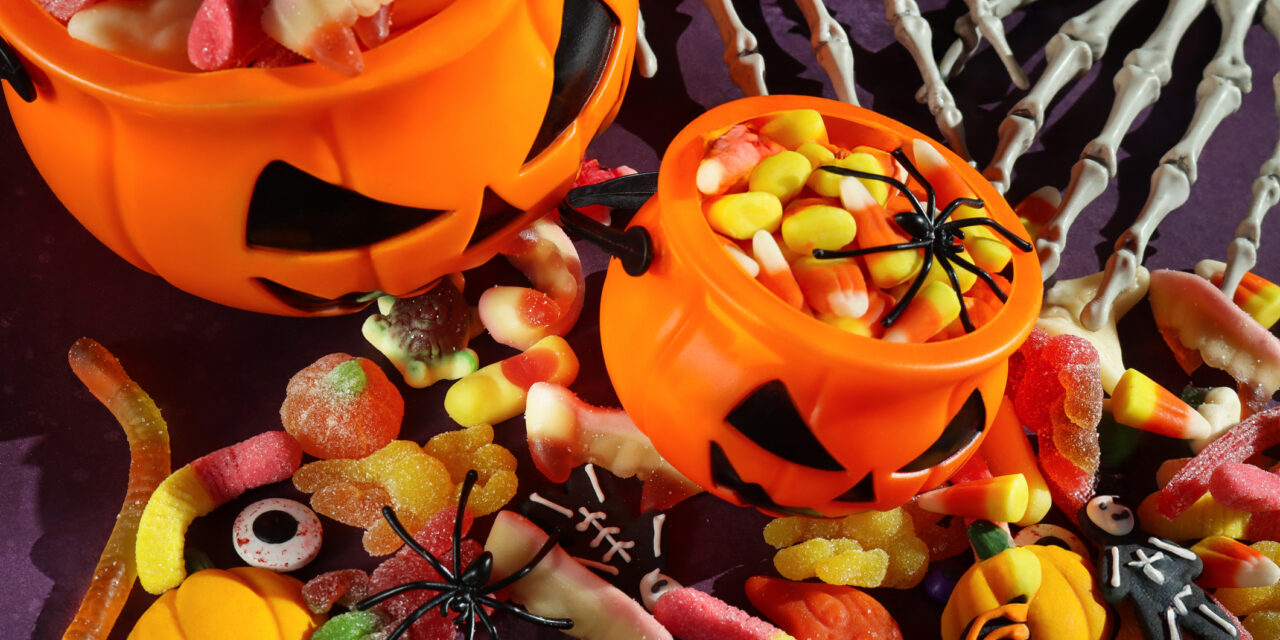Happy Halloween week! Halloween is one of my family’s most anticipated holidays — a time for costumes, creativity, and, of course, treats. My kids have always loved dressing up in costume, and, well… so do I!
For many families, trick-or-treating is the highlight of the season, and candy aisles across the country transform into a colorful display each October. But how did this beloved tradition begin, and how are today’s consumers updating it for modern times? No matter how you celebrate (or don’t celebrate!) this spooky holiday, read on for more info about trick-or-treating and Halloween candy!
History of Trick-or-Treating
According to History.com, trick-or-treating has been a tradition in the United States for more than a century. The origins of the annual parade of costumed children ringing doorbells and demanding treats is a bit murky. Halloween has roots in the ancient Celtic festival of Samhain celebrated on October 31. The Celts, who lived 2,000 years ago, believed that the dead returned to earth on this night, so they gathered to pay homage. Many dressed in costumes to ward off wandering spirits.
During the Middle Ages, the practice evolved into “souling,” when children and less fortunate people would go door to door offering prayers for the dead in exchange for food or small tokens. In Scotland and Ireland, young people participated in “guising,” by dressing up in costume. Rather than praying for the dead, they performed “tricks,” such as singing, reciting poems, or telling jokes, in exchange for treats like fruit, nuts, or coins.
As these traditions made their way to North America, they combined with local harvest festivals and community gatherings. The phrase “trick or treat” first appeared in print in the 1920s, but the practice truly took off after World War II, when sugar rationing ended and Halloween became more widely celebrated.
What’s in the Halloween basket today
Data from National Consumer Panel (NCP) and other retail sources show that Halloween remains one of the biggest seasonal spending events of the year, with candy purchases peaking in October. We recently shared on Facebook and Instagram the top 10 snacks purchased so far this year, and chocolate candy came in at #2 while non-chocolate candy is the fourth-most purchased snack.
While traditional sweets still dominate, today’s consumers are also thinking more about:
- Portion control, choosing smaller or “snack-size” options.
- Allergy awareness, selecting items that are safe for more children to enjoy.
- Ingredient transparency, looking for treats with simpler or natural ingredients.
- Themed packaging and seasonal offerings that add to the festive fun.
According to the National Retail Federation, Halloween spending is expected to reach a record $13.1 billion in 2025. Of this amount, candy is the most popular purchase, with sales expected to reach $3.9 billion.
Beyond Candy: Creative Alternatives
Not everyone chooses to hand out sugar these days, and that’s part of what makes Halloween more inclusive than ever. Many households are mixing candy with non-food or healthier options that still bring plenty of excitement to trick-or-treaters’ bags.
Here are a few creative ideas:
- Non-candy treats: Glow sticks, stickers, pencils, temporary tattoos, or small toys.
- Healthier snacks: Mini bags of popcorn, fruit snacks, or granola bites.
- Allergy-friendly items: Participate in the Teal Pumpkin Project, which encourages offering non-food treats for children with allergies.
- DIY fun: Homemade crafts, Halloween trinkets, or spooky surprises.
These alternatives make it easy to include everyone in the celebration — and they often stand out as the most memorable stops of the night.
However you celebrate Halloween, remember to scan the holiday items you purchase! These items might include candy or other treats, greeting cards, costumes, decorations, and food for Halloween parties.
Tell me: what do you and your family do for Halloween? I’d love to hear more about your own celebrations in the comments!
Regards,
Taylor
Blog comment reminder: If you have a panel-related issue that you need assistance with such as a problem with scanning or your rewards, please contact our Panel Support Center directly and they will be happy to assist you! You can reach them at 1-800-962-6700 or email them at [email protected]. You can also send a message from NCP’s Facebook page. Please don’t enter panel-related issues or share any personal panel membership information in the blog comment section. Any issues will be addressed faster if you contact our support center directly. Thank you so much!



Love Halloween to bad it’s cold and rainy.
It says we can earn point for the blogs is that true if so how?
Hi Tasha, panel members do not earn points for reading the blogs. Can you let us know where you saw this information so we can correct it if necessary? Thank you!
Love the Halloween 🎃 blog and all the wonderful history covered.
I like Holloween decorations there are so many in these years .There was not so many when I was growing up. There are freakier now and more scary looking some look so real they scared me. LoL